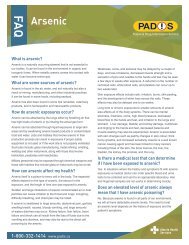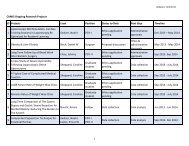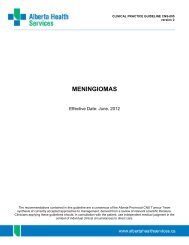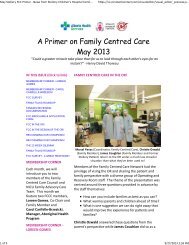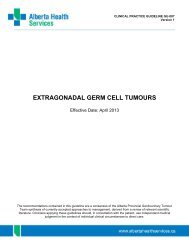taxanes in metastatic breast cancer - Alberta Health Services
taxanes in metastatic breast cancer - Alberta Health Services
taxanes in metastatic breast cancer - Alberta Health Services
You also want an ePaper? Increase the reach of your titles
YUMPU automatically turns print PDFs into web optimized ePapers that Google loves.
BACKGROUND<br />
CLINICAL PRACTICE GUIDELINE BR-001<br />
In 2007, <strong>breast</strong> <strong>cancer</strong> is projected to be the second most commonly diagnosed <strong>cancer</strong>,<br />
and the third<br />
lead<strong>in</strong>g cause of <strong>cancer</strong>-related mortality <strong>in</strong> Canadian women. lead<strong>in</strong>g cause of potential<br />
of <strong>cancer</strong>-related<br />
ith <strong>metastatic</strong><br />
Canadian women <strong>in</strong><br />
ith a <strong>metastatic</strong> relapse<br />
eatment <strong>in</strong> <strong>metastatic</strong><br />
of quality of life.<br />
1 Cancer was the<br />
years of life lost <strong>in</strong> Canadian adults <strong>in</strong> 2003 and <strong>breast</strong> <strong>cancer</strong> accounted for 18.3%<br />
premature mortality <strong>in</strong> women. 1 Approximately 6% of women are diagnosed <strong>in</strong>itially w<br />
disease. 2 This will account for just over 1300 new <strong>breast</strong> <strong>cancer</strong> diagnoses <strong>in</strong><br />
2007. 1,2 Unfortunately, many women with early <strong>breast</strong> <strong>cancer</strong> will be diagnosed w<br />
<strong>in</strong> the years follow<strong>in</strong>g local-regional and systemic adjuvant therapies. The goals of tr<br />
<strong>breast</strong> <strong>cancer</strong> <strong>in</strong>clude prolongation of survival, symptom control and ma<strong>in</strong>tenance<br />
In <strong>Alberta</strong>, chemotherapy for <strong>breast</strong> <strong>cancer</strong> is prescribed at tertiary, associate and community<br />
<strong>cancer</strong><br />
cl<strong>in</strong>ics, which are all affiliated with the <strong>Alberta</strong> Cancer Board. The literature on <strong>taxanes</strong> and <strong>breast</strong> <strong>cancer</strong><br />
has been grow<strong>in</strong>g exponentially s<strong>in</strong>ce the mid-1990’s. In the absence of an evidence-based prov<strong>in</strong>cial<br />
guidel<strong>in</strong>e, it is expected then, that there is regional variability <strong>in</strong> taxane prescription. The<br />
objective of<br />
creat<strong>in</strong>g a prov<strong>in</strong>cial guidel<strong>in</strong>e on the optimal use of <strong>taxanes</strong> <strong>in</strong> the management of <strong>metastatic</strong> <strong>breast</strong><br />
<strong>cancer</strong> is to promote evidence-based consistency <strong>in</strong> practice, and hence, equitable access for patients to<br />
appropriate therapies.<br />
Guidel<strong>in</strong>es for taxane use <strong>in</strong> the management of <strong>metastatic</strong> <strong>breast</strong> <strong>cancer</strong> have previously been published.<br />
The current effort will<br />
be to systematically adapt recommendations of others, and create de novo<br />
recommendations to account for recent evidence.<br />
GUIDELINE GOALS AND OBJECTIVES<br />
To outl<strong>in</strong>e the optimal cl<strong>in</strong>ical use of <strong>taxanes</strong> <strong>in</strong> the management of <strong>metastatic</strong> <strong>breast</strong><br />
<strong>cancer</strong><br />
GUIDELINE QUESTIONS<br />
1. What taxane reg imens can be offered to anthracycl<strong>in</strong>e-naïve patients with <strong>metastatic</strong> <strong>breast</strong> <strong>cancer</strong><br />
(where HER2 is not over-expressed)?<br />
2. What taxane regimens can be offered to anthracycl<strong>in</strong>e-pre-treated/resistant patients<br />
with <strong>metastatic</strong><br />
<strong>breast</strong> <strong>cancer</strong> (where HER2 is not over-expressed)?<br />
3. What taxane regimens can be offered to patients with <strong>metastatic</strong> <strong>breast</strong> <strong>cancer</strong><br />
where HER2 is overexpressed?<br />
4. What are the benefits (time to progression, progression free survival, overall survival, quality of life)?<br />
5. What are the potential toxicities?<br />
DEVELOPMENT PANEL<br />
This guidel<strong>in</strong>e was reviewed and endorsed by the <strong>Alberta</strong> Prov<strong>in</strong>cial Breast Tumour Team. Members of<br />
the <strong>Alberta</strong> Prov<strong>in</strong>cial Breast Tumour Team <strong>in</strong>clude medical oncologists, radiation oncologists, surgical<br />
oncologists, nurses, pathologists, and pharmacists. Evidence was selected and reviewed by a work<strong>in</strong>g<br />
group comprised of members from the <strong>Alberta</strong> Prov<strong>in</strong>cial Breast Tumour Team and a Knowledge<br />
Management Specialist from the Guidel<strong>in</strong>e Utilization Resource Unit.



